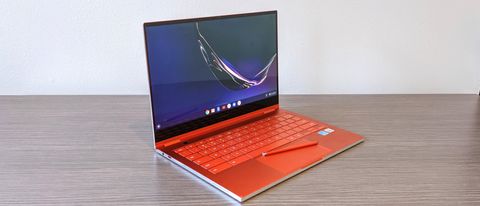Laptop Mag Verdict
With a 4K AMOLED display and a razor-thin chassis, the Galaxy Chromebook is in a class of its own — if only its battery life weren't so dismal.
Pros
- +
Breathtaking 4K OLED display
- +
Razor-thin chassis
- +
Stunning red aluminum design
- +
Fast performance
- +
Built-in S Pen
Cons
- -
Dismal battery life
- -
Weak hinges
- -
Runs warm
Why you can trust Laptop Mag
Price: $999
CPU: Intel Core i5-10210U
GPU: Intel UHD
RAM: 8GB
Storage: 256GB
Display: 13.3-inch, 4K AMOLED
Battery: 5:56
Size: 11.9 x 8 x 0.4 inches
Weight: 2.4 pounds
The Galaxy Chromebook is in a class of its own. Forget about it being a Chromebook -- you won't find another laptop this thin with so much performance, regardless of what OS it runs. Add a 13.3-inch, 4K AMOLED display and it's easy to see why the Galaxy Chromebook is a boundary-breaking machine, not just for Chrome OS but for the industry as a whole.
The bright and saturated AMOLED panel lives up to the billing. Only the Galaxy Chromebook's gorgeous metallic red chassis could stand up to what is one of the best laptops displays we have ever tested.
But while the Galaxy Chromebook might have the best design and display of any portable laptop, its disappointing battery life kills the party. There's also the question of value. Yes, the $999 Galaxy Chromebook has a lot to offer, but it's overkill for most Chrome OS users. For those reasons, the Galaxy Chromebook comes up short of being one of the best Chromebooks you can buy.
Samsung Galaxy Chromebook price and configuration
The only Galaxy Chromebook configuration available today costs $999 and comes with a 13.3-inch, 4K AMOLED display, a Core i5-10210U CPU, 8GB of RAM and a 256GB SSD.
Samsung Galaxy Chromebook design
The Galaxy Chromebook has a bold and beautiful design that makes for the perfect companion to its AMOLED display.
This is the thinnest Chromebook ever, at just 0.4 inches thick, but if the slim frame doesn't catch your eye, the laptop's Fiesta Red finish will. The metallic scarlet finish pops in a way I've never seen before on an aluminum device.
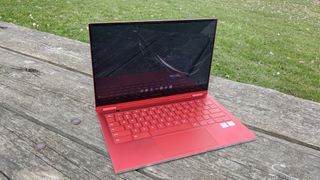
It's a bold design that wouldn't have worked if Samsung hadn't spread the magnificent shade across the entire laptop -- the touchpad, keyboard and even the hinges bleed the fiery hue. I'm also a fan of the laptop's chrome edges, which are a nice contrast to the lovely ruby tone. Samsung also sells the Galaxy Chromebook in a Mercury Gray color variant, but trust us, you want the red.
The design isn't just pretty, it's also practical. On the deck is a fingerprint sensor where you'd normally find a power button (which is on the right side) adjacent to a world-facing camera. Samsung found a way to stash the included S Pen in a slot (or stylus garage) on the right edge.
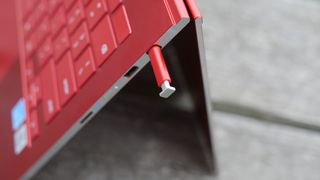
Samsung clearly sweated the details. The laptop has a notch on the front lip to help you open the lid, and the webcam is located on the thin bezel above the screen. I also like how the arrow keys are offset, which makes them easy to find by touch.
As a 2-in-1 laptop, the Galaxy Chromebook uses its flexible hinges to convert into a tablet. You can also position it in tent mode to hide the keyboard when you're viewing content. The hinge rotates smoothly but I worry about its long-term rigidity. The screen wobbled for a few seconds every time I adjusted the angle of the lid, and it moved out of position when I carried the laptop around.
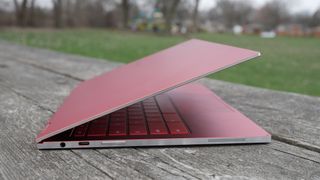
I'm nitpicking here, but I wish the bottom display bezel was as thin as the others because the true edge-to-edge screen on the XPS 13 2020 is a sight to behold.
I want to emphasize the size of this laptop. At 11.9 x 8 x 0.4 inches and 2.3 pounds, the Galaxy Chromebook is thinner than the Google PixelBook Go (12.2 x 8.1 x 0.5 inches, 2.3 pounds), the HP Spectre x360 13 (12.1 x 7.7 x 0.7 inches, 2.7 pounds) and the Asus Chromebook Flip C434 (12.6 x 8 x 0.6 inches, 3.1 pounds).
Samsung Galaxy Chromebook ports
Ports are scarce on the Galaxy Chromebook, but thicker laptops have done worse.
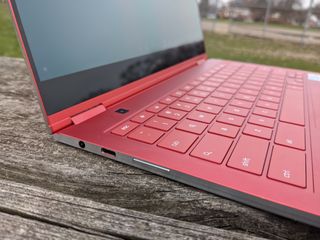
On the left side are a USB-C port and a headphone jack.
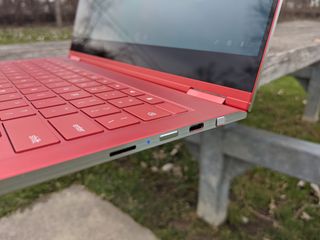
On the right side, you'll find a second USB-C input and microSD card slot.
Samsung Galaxy Chromebook display
The 13.3-inch, 4K AMOLED display on the Galaxy Chromebook isn't just the best panel on any Chromebook, it's one of the best laptop screens ever. The display is bright, vivid and detailed -- qualities that will enhance your Netflix binging or web browsing.
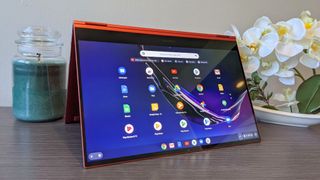
The 4K nature videos on YouTube I've seen countless times took on a new life when I played them on the Galaxy Chromebook. I could see the finest details, like tiny water droplets sitting atop the nose of a turquoise and green snake. Every wooly strand of hair on a slow-moving sloth was in razor-sharp focus. A sunset scene revealed perfect black levels contrasted brilliantly against a vibrant orange sky. I can't overstate the beauty of this panel -- imagine a Galaxy smartphone expanded to 13 inches.
Unfortunately, I found a strange bug while watching YouTube that caused the color saturation to drastically shift when scrolling. I first noticed it watching a Conan video when the comedian's rosy face turned to a ghostly gray. The dull colors remained when I stopped scrolling down.
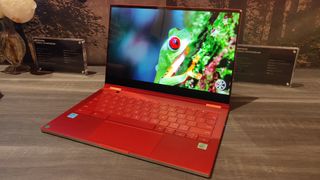
Rich AMOLED tones returned only when I returned to the top of the page. I had the same problem in full-screen and theater mode. The color-shifting issue didn't occur in any other app or webpage I visited, so YouTube might be at fault. I've reached out to Samsung to find out.
The Galaxy Chromebook's touch screen is responsive. I tapped my way through various Chrome web pages without any issues. I hate using the on-screen keyboard but it worked as advertised on the Galaxy Chromebook.
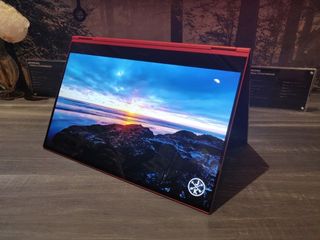
According to our colorimeter, the Galaxy Chromebook's display covers 224% of the sRGB color gamut, making it the fifth-most colorful panel we've ever tested and much more vivid than those on the PixelBook Go (108%), the Spectre x360 13 (109%), the Chromebook Flip C434 (286 nits) and the average premium laptop (125%).
Samsung's panel also gets very bright, although competing laptops put up a fight. At 357 nits of average brightness, the Galaxy Chromebook's screen is a tad dimmer than those on the PixelBook Go (368 nits), the Spectre x360 13 (369 nits) and the category average (362 nits). On the other hand, it's much brighter than the Chromebook Flip C434 (286 nits) and the maximum 536 nits we clocked on the AMOLED panel is dang-near blinding.
Samsung Galaxy Chromebook keyboard and touchpad
The backlit keyboard on the Galaxy Chromebook reminds me of Apple's near-extinct Butterfly keyboard. Stay with me here because the Galaxy Chromebook's low-profile keys are what the Mac's keys should have been, not what they turned out to be.
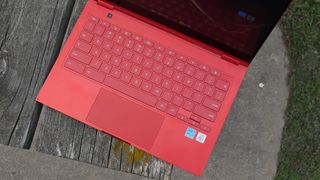
Yes, the keys are very shallow and they start to feel stiff during long typing sessions, but those are faults I could look past thanks to their clicky feedback and large size. Unlike the 13-inch MacBook Pro keyboard, I could feel the keys move up and down, and they didn't fail to register.
I typed at 121 words per minute with a 95% accuracy rate on the 10FastFingers.com typing test, which is faster and just as precise as my typical 119-wpm average.
The 4.6 x 2.3-inch touchpad is smooth and responsive. The bright-red surface responded to my erratic swipes and I had no problems executing Chrome OS gestures, like three-finger swipes to switch Chrome tabs and two-finger swipes to scroll.
Samsung Galaxy Chromebook S Pen
There is no excuse. Every 2-in-1 laptop should have a built-in stylus garage. If Samsung can put one in a 0.4-inch laptop, then every device with stylus support should adopt the feature.
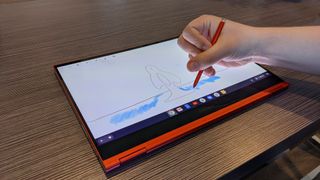
Again, Samsung really thought through the details here. The rectangular S Pen fits in the slot in multiple orientations, so you don't have to fiddle with it. I also love the satisfying click you hear when the pen is inserted.
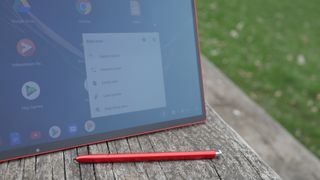
The S Pen itself is nice. I'm no artist but the S Pen wasn't to blame for an embarrassingly bad penguin drawing I sketched using a built-in drawing program. While small and slender, I found the pen comfortable to hold and the sensitive tip let me change line variation on the fly. If the tip isn't to your liking, Samsung packages an extra along with a tool to switch them out.
Samsung Galaxy Chromebook audio
I was pleasantly surprised by the clarity of the speakers on this tiny notebook. Uniquely placed on the side edges of the laptop, the dual speakers played Phoebe Bridgers' "Garden Song" loud enough to fill a small room and even blanket the racket of nearby yard work. Bridgers' smoothing, delicate vocals sounded clear and distortion-free at maximum volume.
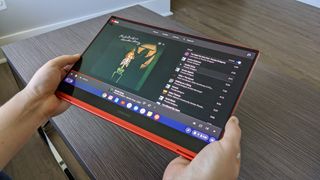
Size limitations became a problem when I listened to Bill Withers' "Lovely Day." Again, vocals and treble sound were clear but the drums lacked punch and cymbal clashes muddled the midrange.
Samsung Galaxy Chromebook performance and graphics
Armed with an Intel Core i5-10210U CPU and 8GB of RAM, the Galaxy Chromebook is the fastest Chromebook in town. Yes, those specs are overkill for most Chrome OS users but I'm not going to complain about excess power. Especially after I loaded 20 Chrome tabs, four of which played 1080p YouTube videos, without a hitch.
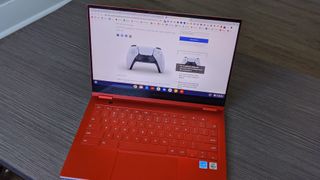
Determined to find its breaking point, I then played a Twitch and Mixer stream and fired up Google Play Music. Finally, the Galaxy Chromebook started to buckle; animations became sluggish and certain apps took a fraction longer to open.
The Galaxy Chromebook crushed our benchmark tests thanks to its 10th Gen U-series chip. It scored a 2,232 on the Geekbench 5 overall performance test, beating out the Pixelbook Go (1,356, Core i5-8200Y). It couldn't keep pace with the Spectre x360 13 (4,074, Core i7-1065G7) but it crushed the Chromebook Flip C434 (6,968, Core m3-8100Y) on the Geekbench 4 test with a score of 13,345.
On the Jetstream 2.0 test, the Galaxy Chromebook scored a 91.9, pushing past the Pixelbook Go (85.9) and the Chromebook Flip C434 (76.7).
Chrome OS
Chromebooks are still popular among students and children, but the market is expanding upward. Premium Chromebooks are becoming more common, although few are as expensive and high-end as Samsung's latest effort. The only competitors in this realm are the outdated Pixelbook and the less-expensive Pixelbook Go.
We expect to see more premium notebooks in this market as Chrome OS booms in popularity and new productivity features are added. The biggest change to Chrome OS in recent years is the addition of Android apps, so people can now download mobile apps on their laptops.
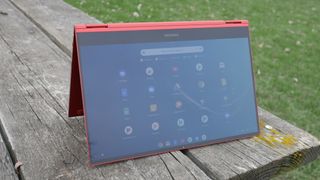
Certain apps still aren't optimized, even three years in. The Slack app, for example, is sluggish compared to the Windows 10 version. Also, many made-for-mobile games take up a fraction of the display. Even the popular game Heads Up! isn't optimized for large displays, presenting itself on the Galaxy Chromebook like a YouTube video shot in portrait mode.
Despite those hurdles, Chrome OS has come a long way from a desktop OS focused around a browser to a genuine Windows 10 and macOS competitor.
Samsung Galaxy Chromebook battery life
Keep the charger nearby. The Galaxy Chromebook lasted only 5 hours and 56 minutes on our Laptop Mag battery test, which involves continuous web surfing over Wi-Fi at 150 nits. Realistically, you won't limit that AMOLED panel to just 150 nits, so expect real-world runtimes of around 3 to 4 hours (I averaging about 3.5 hours).
- Laptops with best battery life in 2020 - longest lasting laptop batteries
We're not surprised. Combine a power-hungry 4K display with a small battery, and endurance will suffer. Still, Chromebooks are expected to provide all-day battery life, and the Galaxy Chromebook didn't come close to the PixelBook Go (11:29), the HP Spectre x360 13 (13:20), the Chromebook Flip C434 (9:58) or even the category average (8:45).
Samsung Galaxy Chromebook webcams
It might share the Galaxy name but don't expect the 1MP webcam on this laptop to rival the image quality of a smartphone's front-facing camera. A selfie I snapped in my dimly-lit apartment was obscured in a thick haze of visual noise. The picture quality didn't get much better when I took the laptop outside on a sunny day.

The colors of my red shirt and blue flannel were spot-on, but I recommend pairing the Galaxy Chromebook with an external webcam.
On the deck of the Galaxy Chromebook is an 8MP world-facing camera. It's an intriguing addition designed to be used in tablet or tent mode. A Samsung rep told me that students can use the Galaxy Chromebook in tent mode to quickly take an image of a whiteboard. I personally wouldn't have used it in class, but I can see it being practical for video calls that let you instantly switch between the front and rear cameras.
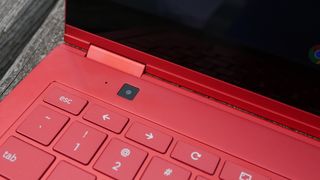
As for the image quality, the 8MP rear camera is night and day over the webcam. A shot I snapped of a plant outside was detailed and the leaves were the correct shade of olive green. It won't replace your smartphone, but the shots are Instagram-worthy.
Samsung Galaxy Chromebook heat
This is where putting a U-series processor in such a slim chassis backfires. The underside of the laptop warmed to a toasty 106 degrees Fahrenheit when we played a 15-minute video at 1080p resolution. Even the center of the keyboard, at 93 degrees, nearly breached our 95-degree comfort threshold. Fortunately, the touchpad maintained a cozy 87 degrees.
Samsung Galaxy Chromebook warranty
The Galaxy Chromebook comes with a one-year limited warranty. See how Samsung fared on our Tech Support Showdown and Best and Worst Brands special reports.
Bottom line
In 2016, we published an op-ed urging Samsung to stop making laptops. The company had tried and failed to make a notebook that could replicate the success of its Galaxy smartphones. The Galaxy Chromebook isn't that laptop. But there is enough innovation in this little package to prove that one day, it could be.
There are things about the Galaxy Chromebook I can't wrap my head around. It starts with the design. At 0.4 inches, the Galaxy Chromebook is among the thinnest 13.3-inch laptops ever made. And yet, it somehow houses a powerful U-series Comet Lake CPU, a stylus slot and a world-facing camera. Add to that a 4K AMOLED display and a stunning fiery-red aluminum chassis, and there's nothing quite like this machine.
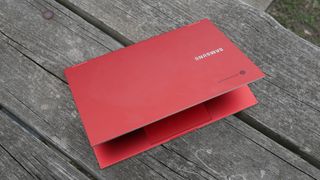
Reality sinks in once you disconnect the Galaxy Chromebook from its charger. The dismal battery life of under 6 hours undermines the advantages of the Galaxy Chromebook's ultra-portable design. Of course, the way to improve battery life is by replacing the 4K AMOLED display, but that's an unacceptable concession once you've seen this screen in person.
If you won't leave the Galaxy Chromebook unplugged for long periods, then there is no better Chromebook. But if you travel frequently or just don't like being tethered to an outlet, then save some money and get the PixelBook Go instead. In the end, I still want Samsung to make a Windows 10 version of the Galaxy Chromebook because it's only one fault away from being the best laptop on the market.
Phillip Tracy is the assistant managing editor at Laptop Mag where he reviews laptops, phones and other gadgets while covering the latest industry news. After graduating with a journalism degree from the University of Texas at Austin, Phillip became a tech reporter at the Daily Dot. There, he wrote reviews for a range of gadgets and covered everything from social media trends to cybersecurity. Prior to that, he wrote for RCR Wireless News covering 5G and IoT. When he's not tinkering with devices, you can find Phillip playing video games, reading, traveling or watching soccer.
